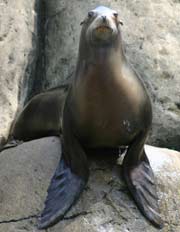|

Females only a third the size of males: The California Sea Lion (Zalophus californianus) is a coastal sea lion of the northern Pacific Ocean. Males grow to 300 kg (600 lb) and 2.4 m (8 ft) long, while females are significantly smaller, to 100 kg (200 lb) and 2 m (6.5 ft) long.
 Streamlined systems: The California Sea Lion has a streamlined body that contains a layer of blubber under the skin to provide warmth and buoyancy. Their large eyes help them adjust to low levels of light in underwater environments, while their whiskers augment their sense of touch. Their nostrils automatically close once they hit the water. Their long front flippers rotate outward for better movement on land, and propel them forward in water, where they are most at home. Males grow a large crest of bone on the top of their heads as they reach sexual maturity, and it is this that gives the animal its generic name (loph is "forehead" and za- is an emphatic; Zalophus californianus means "Californian Big-head"). Streamlined systems: The California Sea Lion has a streamlined body that contains a layer of blubber under the skin to provide warmth and buoyancy. Their large eyes help them adjust to low levels of light in underwater environments, while their whiskers augment their sense of touch. Their nostrils automatically close once they hit the water. Their long front flippers rotate outward for better movement on land, and propel them forward in water, where they are most at home. Males grow a large crest of bone on the top of their heads as they reach sexual maturity, and it is this that gives the animal its generic name (loph is "forehead" and za- is an emphatic; Zalophus californianus means "Californian Big-head").


Sociable sea lions: California Sea Lions feed on a wide variety of seafood including fish, shellfish, and squid. They are highly sociable and gather in large numbers on beaches and coasts, though they are also often associated with marinas and wharves, and may even be seen on navigational buoys.
Intelligent and often trained: California Sea Lions are intelligent and adaptable, and are often trained as entertainers at ocean parks and zoos as well as by researchers studying interspecies cooperation in the marine environment. They are also used in military applications as sentries, and for equipment recovery, by the U.S. Navy Marine Mammal Program.

This species usually breeds around May to June and females have a 12 month gestation period. The pup is usually born from June to August, and the mother may give birth in land or water.

 There are three subspecies, sometimes considered full species in their own right: Zalophus californianus californianus is the nominate race, found primarily along the Pacific coast of North America. The others are the Galapagos Sea Lion (Z. c. wollebaeki), and the Japanese Sea Lion (Z. c. japonicus) which is now believed to be extinct. There are three subspecies, sometimes considered full species in their own right: Zalophus californianus californianus is the nominate race, found primarily along the Pacific coast of North America. The others are the Galapagos Sea Lion (Z. c. wollebaeki), and the Japanese Sea Lion (Z. c. japonicus) which is now believed to be extinct.
California sea lions are the only mammals whose milk does not contain lactose.
All text is available under the terms
of the GNU Free Documentation License
|